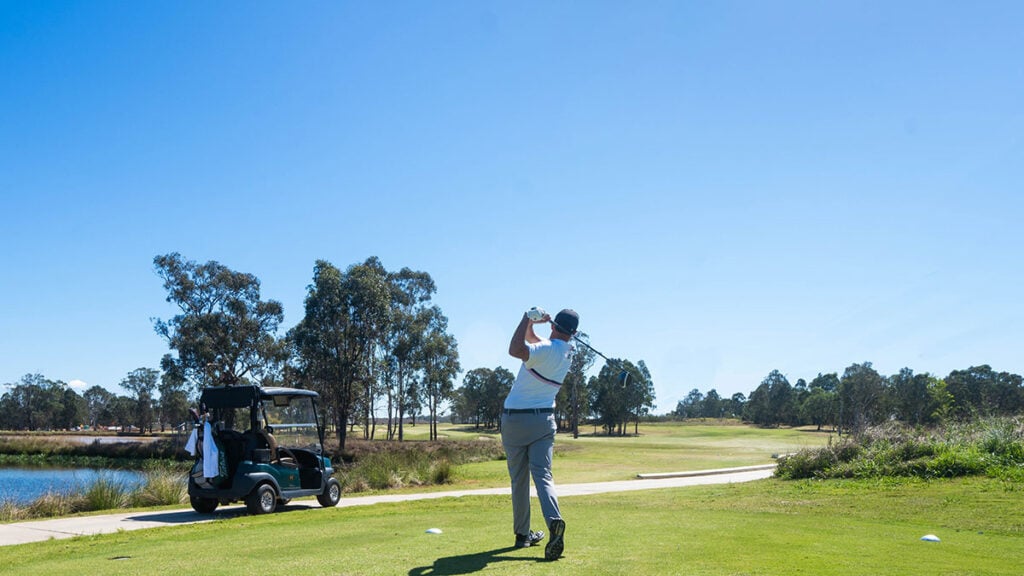Forever fresh-faced Jordan Spieth showed up with the beginnings of a beard at the John Deere Classic. It was a remnant of his post-US Open vacation in the Bahamas, but while his earnest effort was far from thick stubble, it did manage to approximate the look of extra intensity pro athletes like to convey with new facial hair before their biggest games.
From his junior days, Spieth has habitually been at his best in big games, but even though he has won the year’s first two Majors, the sports-crazed Texan is facing his biggest game ever at the British Open at St Andrews. The ferocious concentration he has built up for the occasion was on display at the Deere, where a weary start (even par after 22 holes) still resulted in a successful finish, Spieth beating Tom Gillis in a playoff for his fifth US PGA Tour title. Sure, he might have wanted to show some critics that he didn’t make a mistake playing in Illinois rather than going to Scotland early. But the 21-year-old has gotten himself in full go-mode for his chance to equal Ben Hogan’s 1953 feat of winning the year’s first three Majors, and then, if successful, the calendar-year Grand Slam.
Spieth projects a natural humility, giving him the room to forthrightly announce voracious goals. Since he began playing the US PGA Tour in 2013, he has unabashedly said he wants to be No.1 in the world and, as the current No.2, he is on the cusp. After he won the Masters, he was asked what about playing at St Andrews he was most looking forward to. “Hopefully, at that point, maybe try and go for the third leg of a Grand Slam,” he said, causing some laughter among the media. “Can’t win four unless you win the first, right?”
Yeah, he was thinking about it enough to say it, and nobody’s laughing now. Tiger Woods used to get eye rolls when, as an amateur playing US PGA Tour events, he would say his goal that week was to win. If he hadn’t felt that way, his victory explosion upon turning pro wouldn’t have happened.
Speaking of Woods, it was the Tiger Slam completed in 2001 that most makes Spieth’s current assault plausible. It’s the golf feat in the post-Masters era that is exceeded in its impressiveness only by Byron Nelson’s 11 straight victories. True, Woods’ accomplishment lacked the sublime buildup and symmetry of the calendar Grand Slam. But does anyone think if the then 24-year-old Woods had happened to win the 2000 Masters, winning the next three would have been beyond him?
Tiger’s precedent is not the only thing in the air. Serena Williams, who already possesses a Tiger-esque Serena Slam, just won at Wimbledon and needs only the US Open in September to become the first woman to win tennis’ calendar Grand Slam since Steffi Graf in 1988.

Last month, American Pharoah became horse racing’s first Triple Crown winner in 37 years. Time-honored records are falling so fast, and Grand Slam talk is so prevalent, it has made Hogan’s Triple seem like it’s due to be equalled.
Statisticians at Nate Silver’s FiveThirtyEight.com have calculated the chances of Spieth doing that at a little more than 10 per cent. However, the current odds of Spieth winning at both St Andrews and the PGA Championship at Whistling Straights – even with Rory McIlroy out of the first and perhaps the second – are about 1 per cent.
At the risk of sounding like one of those anti-analytics humbugs, it just seems he has a better chance than that. Spieth has already established himself as one of the sport’s Mr. Intangibles, the kind of athlete who is difficult to quantitatively measure in terms of skill, but who possesses an uncannily effective ability to get it done.
Not that Spieth’s march at a Slam feels anywhere near inevitable. The previous players since Hogan who have won the first two legs – Arnold Palmer in 1960, Jack Nicklaus in 1972 and Woods in 2002 – all stood atop the game with more authority than Spieth. Apart from his putting and wedge play, Spieth’s best golf doesn’t inspire awe. Indeed, in a situation in which McIlroy, Dustin Johnson and Bubba Watson were all at the top of their games, Spieth might well finish fourth.
But the purists who have underestimated Spieth as a mediocre ball-striker carried by the unconscious putting of youth have been proved wrong. First of all, Spieth has a well-rounded game through the bag with no glaring weakness, that in itself is a significant strength. Secondly, and crucially, the kid is special mentally.
At the Masters, the power of Spieth’s mind was on display not only in the poised way he closed the show, but in his winner’s press conference. At the end of an already long session, he was asked by a Masters official to “please go through your card.”

Spieth, rather than blow through his birdies and bogeys in a way that would have been understandable given the circumstances, instead went on a detailed journey of explanation that totalled more than 2,500 words for all 18 holes, beginning with this recounting of the first hole: “I hit a 3‑wood off No.1 tee box and had a good kind of smooth 9‑iron into the green. Tried to bleed a little fade. Got it to land where I wanted and putt where I wanted to, which was a very straight putt coming right back up the hill.”
After winning at Chambers Bay, his in-depth analysis of the way he played the 72nd hole, where he arrived after a disastrous double-bogey and knew he needed a birdie, also revealed an exceptional sense of golfing nuance and clear thinking under pressure.
“Yeah, I hit a little fade on the tee shot. The wind was down and a little off the right, which is a perfect opportunity for me to try and play a nice, just soft fade. I didn’t have to kill it. … The only thing I couldn’t do is, I couldn’t pull it, because then you’re up in that bunker. … I struck it right in the middle of the face and just wanted it to land soft. … And I got up there and I had a perfect number: 250 front edge, 282 hole-adjusted. For my 3-wood that flies typically 265 yards or so, I could just kind of bleed a fade off of it and try to land it on about that number, 15 to 20 onto the green and I shouldn’t hit it further than 290, which is about the back. … I hit it right on the middle of the face and I looked up and it was bleeding right. I just asked for the wind to hold it up just a little bit.”
As long as his physical game is in solid shape at St Andrews, and based on the Deere it is currently better than that, the above constitutes Spieth’s biggest weapon in his assault on history.
But there’s also no doubt things have been breaking right for Spieth. Consider the fish story he brought back from the Bahamas.
After hooking a large tuna and fighting to land him, Spieth suddenly felt a gigantic yank that almost pulled him out of the boat. It turned out that a 300-pound, 12-foot-long black-tipped shark had swallowed the tuna and gotten hooked on the line. Spieth, naturally, dug deep for another two hours plus and reeled the combo platter in.
To stretch the metaphor, Spieth has already caught two tunas and will be
focused only on hooking a third at St Andrews. But if and when the shark in the form of the impending Triple or even Grand Slam jumps on the line, this special young man will be capable of landing the big one.




